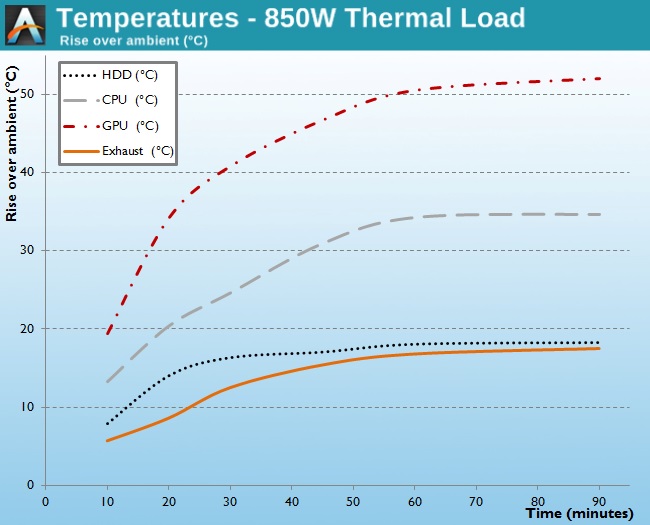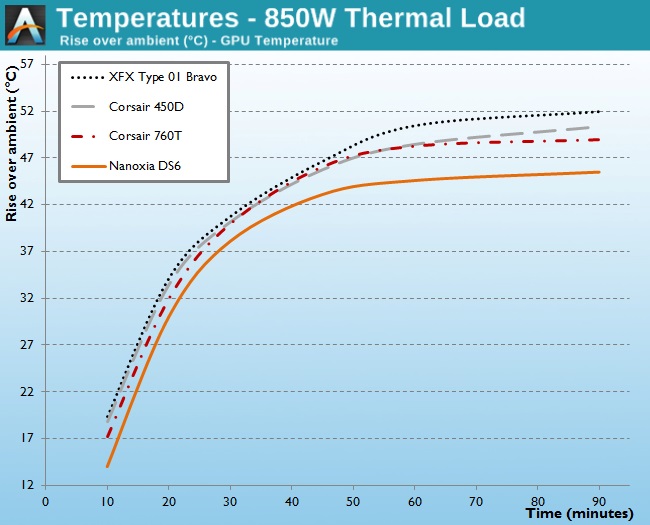XFX Type 01 Bravo Case Review
by E. Fylladitakis on May 16, 2014 6:00 AM EST- Posted in
- Cases/Cooling/PSUs
- XFX
- mid-tower
- Case
Test Setup
Professional testing requires the emulation of real-world situations but with repeatable results; thus, a perfectly controllable test setup and environment are required, especially for comparable results. Testing the thermal performance of any case with a typical real-world setup technically limits the comparability of the results to this setup alone, as an active system interacts with its environment and the change of a single component alters (albeit in small ways) myriads of variables. In order to eliminate such factors, we developed synthetic loads that emulate the thermal output of real systems that are passive, steady and quantifiable.
Our thermal testing now displays the thermal capabilities of the case alone, as if it must deal with the entire thermal load by itself, regardless of the system that might be installed inside it. Laboratory data loggers are used to monitor the PT100 sensors and control the safety relays, which are fully accessible via our custom software. Three such loads have been developed, and today we'll be using the ATX load.
The ATX version simulates a 200W CPU, 50W VRM, 30W RAM and 4 × 120W GFX card thermal load; additionally, three 3.5" HDD dummy loads are also present that each convert 30W of electrical power to thermal, bringing the total thermal load of the ATX test setup up to 850W. As such, the thermal load is immense and only the best of cases will be able to handle it for more than a few minutes. We also test with a thermal load of 400W, with all of the aforementioned components except the HDD drives at about 42% power, which is more suitable for the majority of cases.
Thermal testing is performed with all of the case's stock fans operating at maximum speed. Standard noise testing is performed with a background noise level of 30.4dB(A). Advanced noise testing is also being performed, in order to assess the ability of the case to dampen the noise of the components installed inside. This includes the installation of two noise-generating sources (strong fans) inside the case, one positioned approximately over the first expansion slot and one over the CPU area, which generate ≈ 44.2 dB(A) when unobstructed. During the advanced noise test, all stock cooling options of the case are entirely disabled.
Results and discussion
Unfortuantely, the thermal performance of the XFX Type 01 is rather mediocre. We cannot deny the fact that we expected more from a case with lots of ventilation and a 200 mm fan installed, yet the Type 01 Bravo can hardly compete with mid-tower cases of similar internal proportions. After all, the Type 01 Bravo is, as far as dimensions are concerned, a typical mid-tower case with plastics that add a lot of bulk. When compared to a high performance (and significantly more expensive) gaming case, the XFX Type 01 Bravo falls behind in terms of thermal performance. To illustrate this, we have created additional graphs showing other cases that we have tested using our new procedures. We are focusing on the two hottest components for these charts, the CPU and GPU loads.
The other side of the story is that the stock cooling fans of the XFX Type 01 Bravo are very weak. Although this obviously has a great effect on thermal performance, it also means that the XFX Type 01 Bravo generates very little noise. Even with its fans running at maximum speed, the XFX Type 01 Bravo generated levels of noise barely perceptible from one meter away.
Considering the fact that the design of this case is not really meant to dampen the noise of the system, the stock cooling system of the XFX Type 01 Bravo may not be powerful but it certainly is efficient considering the small amount of noise it generates. When additional noise sources are present, the acoustic performance of the XFX Type 01 Bravo is mediocre, as the design of this case (and most cases optimized for airflow) has virtually zero noise-dampening capabilities.















28 Comments
View All Comments
asendra - Friday, May 16, 2014 - link
I know this is not directly related to the post (which by the way, that's an ugly case if I ever saw one..) but, can anyone point me what brand are those power cables he is using with the psu? I know they are not the standard ones for that psu, and I've seen them in more places, but I can find them any where. (maybe I don't know how to look for them)I have a new build with a node 304 and a seasonic g-650 psu, and cable management is a issue with the cables it came with.
If anyone can shed some light, I would really appreciate it.
munim - Friday, May 16, 2014 - link
It could be MDPC sleeving.Ninhalem - Friday, May 16, 2014 - link
Doesn't look like MPDC sleeving. The weave isn't as tight as MDPC. More like paracord or LutroO Teleios.jmbnbn - Friday, May 16, 2014 - link
Although I can't be sure, I suspect these are the Corsair provided sleeved cable sets:http://www.corsair.com/en-gb/power-supply-units/ps...
jmbnbn - Friday, May 16, 2014 - link
Also yes, that is a horrible looking case. The front kind of reminds me of the Dell XPS 720 though, which makes me slightly sympathetic because that was a great case.E.Fyll - Friday, May 16, 2014 - link
jmbnbn is correct, Corsair supplied us with these colored sleeved cable sets specifically for these reviews, as we wanted the cables standing out in the pictures.arealMESSiah - Saturday, May 17, 2014 - link
They look like the Corsair individually sleeved cable kit.http://www.corsair.com/en-us/individually-sleeved-...
http://www.corsair.com/en-us/professional-individu...
RonanH - Friday, May 16, 2014 - link
that is one fugly case :oAndrewJacksonZA - Friday, May 16, 2014 - link
<fluff>Typos on page 3:
"(along with the red XFX logos on the sides) are teh only exceptions." Spelling.
" You'll also want to make you don't tie that cable down anywhere" Missing word.
"the width of the drive cage can be reduced it can be removed completely" Missing comma.
</fluff>
In my opinion the case is... an acquired taste. I'm sure some people will like it, but not me: the ventilation slots made me think of boring office computer cases from the early 2000s.
Also, it's a pity about the thermals and noise of this case.
LordOfTheBoired - Friday, May 16, 2014 - link
Oddly, the slots have made me think only one thing, since I saw the picture of the box. Large flat space, end-to-end slats, small flat space... at least from the side, It's a chubby NES.